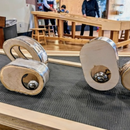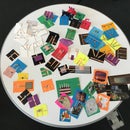Introduction: A Playset for Tinkering With Balance
In this guide, you'll learn how to make a balancing playground - a simple set of robust, reusable play materials for learners to construct their own expressive, moving sculptures. As they play with this set of materials, learners experience and explore the concepts of counterbalance, torque, weight and center of mass while they create a personally meaningful kinetic sculpture and add story elements to bring it to live.
You will build a sturdy base that makes it easy and safe for learners to set up balance experiments alongside with a set of starting points that help learners to get going without prior knowledge. You will also build a set of modular materials designed to support iteration and discovery through trial-and-error.
Once you have the basic set, you will get hours of play and learning out of it, and you will be able to expand it to try more ambitious constructions.
We developed this tinkering activity in collaboration with Wonderful Idea Co.
Supplies
Essential materials:
- triangular wooden pattern blocks or other triangular wooden shape
- metal clothespins
- square dowels 1/4"
- square dowels 3/16"
- heavy washers or similar for weights
- colorful HDPE plastic or cardboard for expressive shapes
- for the stand: 3' long 1" diameter wooden dowel rod. PVC cap fitting. Flat wooden base.
Tools for shapes:
- hot glue
- scissors
- box cutter
Tools for base:
- power drill
- 5/16" drill
Nice to have:
- colorful 1.5" D wooden balls
- Epoxy 3M DP 100 Plus for stronger connections
- laser cutter to make shapes
- steel wire (0.125"D) to make organic looking sculptures
- 1" spade bit for different base constructions (see below)
Step 1: Make a Balancing Point
These starting points allow learners to experience the concept of balance and quickly dive into the exploration of the phenomenon.
Seesaw starting point:
- Cut a 3' long piece of 1/4" square dowel and glue a triangular pattern block or a small (0.5" tall) triangular piece of wood to it. Centering the triangle on the stick will make balancing easier, but off-set positions can make for visually interesting asymmetric set-ups.
Ball starting points:
- Drill a 5/16" hole through the center of a wooden ball. Turn the ball by 90 deg and drill another hole through the center of the ball. Press-fit a 3' long square dowel into each hole. To make more challenging and unique balancing set-ups, try using shorter dowels and different lengths on each side.
Step 2: Make Connections
For each balancing point, make 10 connector pieces that learners can use to construct a unique shape.
- Cut 3/16" square dowel into 8" long pieces and glue a metal clip to each one. Hot glue will work, but for lasting connections, we prefer 3M DP100 Epoxy.
Step 3: Weights
Weights and dense/heavy objects are an important ingredient for creating stable structures and can also lead to surprising and seemingly impossible constructions. For each balancing point, make 10 weights.
- We use a 1.5" diameter fender washer with a zip tie glued to a metal clip
Step 4: Add Color and Story
For each balancing point, make a couple of interesting shapes that inspire aesthetic expression and story telling. We use 1/32" thick HDPE plastic to create durable shapes that can be used over and over, but colorful card stock works well, too and has the advantage of being lighter than plastic.
- Use the attached file as a template to create shapes or invent your own
- Glue a metal clip to each shape. Again, hot glue or epoxy work.
Step 5: A Solid Base
A sturdy base with a landing zone area provides an inviting space for creating balancing sculptures.
- A simple way to construct a sturdy base and easy to store base is to attach a PVC 3/4" PVC cap fitting to a heavy wooden platform. Insert a 1" dowel rod into the cap fitting, using electrical tape wrapped around the inserted end to ensure a tight fit. To make it a little harder for balancing sculptures to topple all the way off of the stand, you can glue a flat washer or cup washer to the top.
- You can also use a spade bit to drill a 1" hole into a 2' long 2"x4" piece of wood and glue a 4" piece of 2"x4" to each side to create a cross shaped base for the stand. Stick a 1” round dowel, 1' tall or higher, or anything that can serve as a perch (like a broom stick) into the base to create a portable stand.
- For a more sturdy version that also provides space for loose materials, consider building a cylinder base (20" table height, 31"D) similar to the one we use in the Tinkering Studio.
Step 6: Play and Expand
This set can be expanded in multiple ways. Learners can create their own expressive shapes and add them to the set, natural and found materials are great additions, too. Creating a set with everyday materials, like using pencils as extender pieces and spoons as weights, can be fun too. The materials set can be adapted for younger learners by using easy to open clips and cup washers to keep the balance point from falling off the stand as often.
We've collected some of the incredible ways different places have picked up these ideas and adapted them to their contexts. Check out this showcase and let us know what you change, try out, and improve!
Step 7: Reflect and Share
We believe reflection is an important part of tinkering, so we developed this zine as a tool to support reflecting on the process of designing this inventive playset and adapting it to your own setting.
We are big believers in open prototyping and we would love to see how you are remixing or improving the balancing sculpture concept! Please share your build, questions, and work in progress here or on Twitter with #ExploringBalance@TinkeringStudio.






